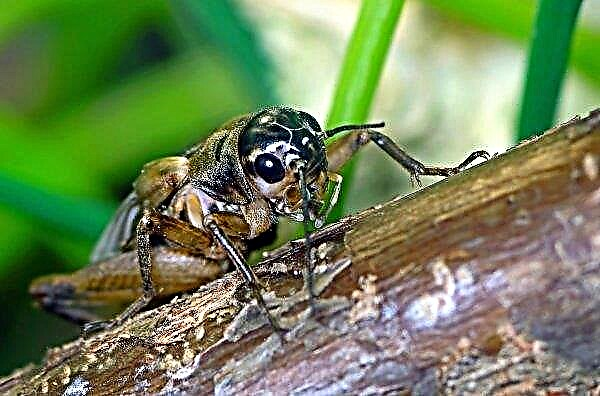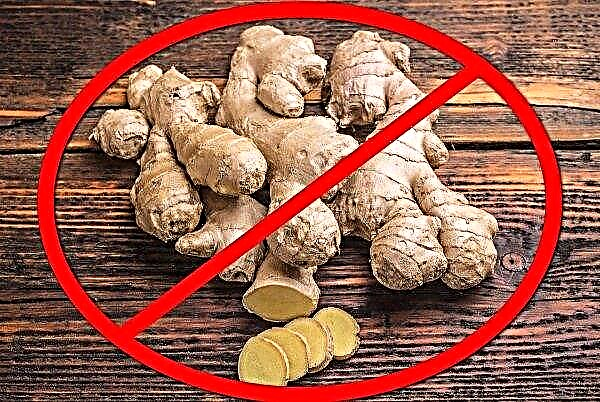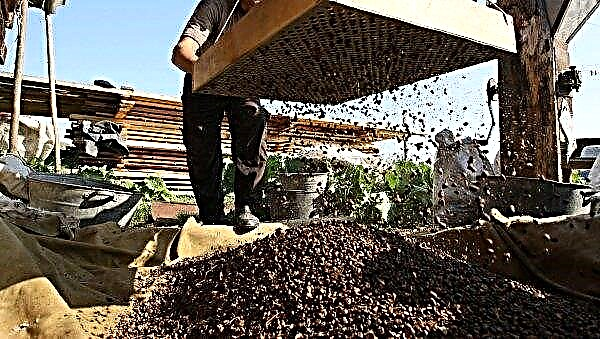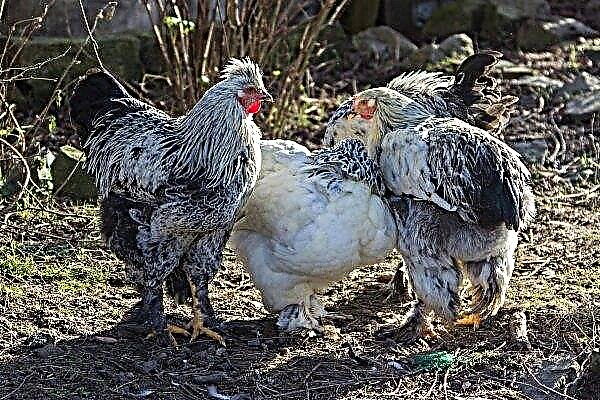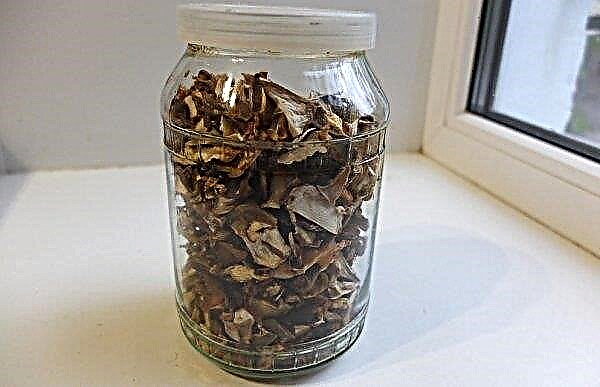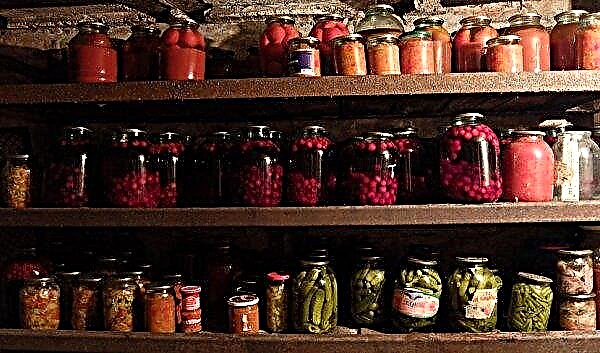Diseases of chickens are found no less than diseases of other farm animals, which means that the issue of their death will always be relevant. Problems with the legs of birds take almost the first place in the list of all possible problems, so let's look at the possible causes of this phenomenon and how to eliminate them using broilers as an example.
Why broilers get on their feet
Leg problems are common to both small broilers and adults. True, there are a lot of reasons for their development, so before treating a bird, you should understand the root cause of what happened.
Unacceptable conditions
Violation of the sanitary and hygienic norms of broiler keeping is not the only, but one of the first “suspects” when the legs of the chickens fail. The main criteria to assess the very "norm" should include:
The main criteria to assess the very "norm" should include:
- bird density - there should be no more than 5 individuals per 1 sq. m;
- regular house cleaning - should be done at least 1 time in several weeks (in a limited space, bacteria develop very quickly, which leads to the appearance of various ailments);
- excessive sterility of the room - Frequent cleaning leads to the destruction of beneficial bacteria, due to which the immunity of the bird suffers and its natural microflora is disturbed;
- ignoring the start of the problem - if there are already several broilers in the chicken coop with "spreading legs", you cannot leave them together with healthy individuals;
- violation of the rules for arranging ventilation and fresh air - high humidity and stagnant air are excellent "soil" for the development of pathogens;
- unsanitary conditions for feeders and drinking bowls - Normally, they need to be cleaned at least once every few days, especially if the bird is given wet mixes.
Usually, changes in the conditions of detention are quite enough to localize the problem at its initial stages of development and to avoid more serious consequences. However, if the ailments of the legs of adult broilers or chickens are massive, then it is worth considering other possible causes of their development.
Did you know? In fact, chickens are not as stupid as many people think. From the first hours of their life, they can count, and the general level of development of chickens is much higher than that of a one-year-old human cub.
Avitaminosis
For both humans and animals, a full and properly balanced diet, with enough vitamins and minerals, plays a significant role in well-being. With their shortage, they talk about vitamin deficiency, which in the case of broilers is often manifested on those farms where the bird is fed exclusively with feed mixtures. For the full growth and development of young animals and the high productivity of adults, they just need greens, as well as raw and boiled vegetables (for example, cabbage, beets, zucchini and carrots).
For the full growth and development of young animals and the high productivity of adults, they just need greens, as well as raw and boiled vegetables (for example, cabbage, beets, zucchini and carrots).
For lack of these products, veterinarians advise using ready-made vitamin-mineral compounds. Starting from the age of five days, it is useful for chickens to give preparations containing vitamins A, D and E, which are either mixed with food or instilled into the chicks drop by drop.
If you decide to replenish the vitamin reserves of birds with the help of natural products, then you should pay attention to sprouted grain and seasonal greens. The rate of delivery of such food is not limited, the main thing is that poisonous specimens should not come across in the collection of herbs.
Supporting the optimal ratio of vitamins and minerals in the body is an excellent prevention of broiler mortality.
Important! An excess of nutrients is just as harmful as their lack, therefore, if you decide to give ready-made veterinary preparations to the bird, be sure to strictly follow the instructions.
Possible diseases
Violation of sanitary and hygienic standards when keeping a bird and ignoring its needs for nutritional components, of course, create excellent conditions for the development of ailments, but the development of infectious and bacterial processes in the body will bring much more harm.
Many of them are characterized by leg failure, but among the most common causes of death are the following.
Rickets
Unlike other diseases, rickets is most often manifested in young individuals and is explained by a lack of vitamin D. However, one should not exclude the likelihood of its appearance in adult chickens, especially if they were kept in inappropriate conditions since childhood.
Violation of metabolic processes in the body and a decrease in calcium concentration lead to a deterioration in the formation of bone tissue, which causes broiler legs to weaken. If the bird is kept only in enclosed spaces with limited exposure to sunlight, signs of rickets are observed in almost all representatives of the chicken herd.
Do not forget that the mentioned vitamin D is the only trace element whose formation occurs in the body exclusively under the influence of ultraviolet radiation, so chickens that spend more time in the fresh air are much less likely to experience changes in bone tissue, and therefore leg problems are reduced to a minimum.
As for the main symptoms of rickets in broilers, then they include:
- disheveled appearance and lack of plumage;
- limited mobility;
- decreased appetite;
- impaired coordination of movements;
- softening beak and claws;
- loss of strength and death.
 If for several weeks the owner did nothing to prevent the further development of the disease, then the state of birds will worsen every day, right up to the death of a sick bird.
If for several weeks the owner did nothing to prevent the further development of the disease, then the state of birds will worsen every day, right up to the death of a sick bird.Newcastle disease
Newcastle disease is not unreasonably considered one of the most dangerous viral ailments of the bird, because the percentage of deaths is very high. Infection of healthy individuals occurs both in direct contact with a sick bird, and as a result of the joint use of feeders and drinkers.
The incubation period is usually 7-12 days, but weak individuals can die as early as the first day after infection.
You can notice the development of the disease (if it does not occur in a latent form) by the following signs:
- impaired coordination, paralysis of the limbs and neck;
- decreased appetite, diarrhea;
- discharge of mucus from the nose and beak, coughing, coughing;
- the appearance of vision problems (usually conjunctivitis and blurred eyes);
- increase in body temperature;
- inactive and depressed state.
In some cases, Newcastle disease takes a chronic form and manifests itself in:
- limited mobility;
- the appearance of seizures in the limbs and cervical spine;
- loss of appetite and general exhaustion of the body;
- overexcitation of the nervous system, expressed in the swaying or twitching of the head.
 In the latter case, the chances of saving broilers are greater, and with adequate treatment, it will be possible to reduce the likelihood of death to 15-30%.
In the latter case, the chances of saving broilers are greater, and with adequate treatment, it will be possible to reduce the likelihood of death to 15-30%.Important! Newcastle disease can affect any type of poultry, so broilers are often infected by contact with ducks, geese or turkeys during a joint walk.
Pullorosis
This disease has an infectious origin and is more characteristic of young broilers. Among the main causes of the development of the disease, poor nutrition of the bird and violation of sanitary and hygienic standards of its maintenance are noted, which only contributes to the spread of the pathogen - the bacteria Bacillus pullorum.
The main symptoms of damage to chickens by pullorosis are:
- sedentary lifestyle due to weakness in the legs;
- constantly closed eyes;
- frequent breathing only through the beak (therefore, it is always open);
- white diarrhea;
- exhaustion of the body;
- constant feeling of thirst.
Of course, when detecting sick individuals, they must be immediately isolated from a healthy livestock, and the premises, feeders and drinking bowls should be treated with disinfectants. For the treatment of pullorosis in broilers, Biomycin is usually prescribed with the addition of Furazolidone to the feed mixture. For preventive purposes, it is recommended to ventilate the house more often and conduct its sanitary treatment in a timely manner.
For preventive purposes, it is recommended to ventilate the house more often and conduct its sanitary treatment in a timely manner.
Marek's disease
Another dangerous disease of an infectious nature, which is characterized by damage to the nervous system and broiler eyes.
The incubation period has quite wide limits and can last from several weeks to 150 days (the specific time for the development of the disease depends on the age of the birds, their health status and individual characteristics of the immune system).
The characteristic symptoms of Marek’s disease are mainly due to the form of its course (acute or classical), but almost always the following are noted in the list of main symptoms:
- disorientation in space, which leads to constant falls and trauma to diseased individuals;
- loss of appetite and rapid exhaustion of the body;
- narrowing of the pupil and change in the iris;
- blanching of growths on the head;
- weakening of motor activity;
- decrease and complete loss of vision (the bird just stands in one place or when moving constantly falls to one side).
Unfortunately, there is still no effective method for treating Marek’s disease, and the only effective method is prevention with the timely use of a suitable vaccine.
Did you know? Images of chickens were found during excavations of the tomb of Tutankhamun, which means that people knew, and possibly bred them back in 1350 BC. e.
At the initial stages of the development of the disease, before the bird began to fall on its feet, the drug “Acyclovir” can sometimes be used as antiviral therapy, but even in this case, one hundred percent effectiveness of such treatment cannot be guaranteed.
Coccidiosis
A bacterial disease that affects mainly young broilers up to three months of age. The cause of the disease may be one of the eleven possible types of pathogen bacteria that enter the body of a healthy bird along with the secretions of the patient (when kept together) or through insect bites.
Sometimes, the coccidiosis carrier is the person himself, using equipment and clothing untreated after contact with a sick bird.
The exact time of the incubation period is very difficult to determine, since in each individual case the duration of the "hidden" phase is different, and only when the bacteria are already firmly settled in the feathered organism, the following symptoms become noticeable:
- lethargy, depression and apathy (chickens may refuse to leave their perches);
- lack of appetite and, as a result, weakening of the body due to lack of nutrients;
- lack of coordination;
- bloody diarrhea;
- constant presence near a heat source (more typical for small chickens, which, due to exposure to bacteria, constantly feel cold).
 The fastest and most effective way to determine the presence of coccidiosis is to examine dead birds in the laboratory. When confirming the diagnosis and the presence of the first signs of illness in surviving birds, they are prescribed complex preparations, for example, Baykoks or Amprolium.
The fastest and most effective way to determine the presence of coccidiosis is to examine dead birds in the laboratory. When confirming the diagnosis and the presence of the first signs of illness in surviving birds, they are prescribed complex preparations, for example, Baykoks or Amprolium.Aspergillosis
An ailment of fungal origin, affecting the respiratory system of mainly young broilers. Most often, infection of the bird occurs through the use of infected feed, the use of straw or other litter material, and the development of the disease can be observed at any time of the year.
Aspergillosis is considered one of the most dangerous ailments, characterized by such manifestations as:
- apathetic and lethargic state;
- hoarseness
- decreased or complete lack of appetite;
- rapid and labored breathing;
- growth lag.
 In the acute form of the course, the probability of death among young individuals reaches 80–100%. The chronic form is more characteristic of adult broilers and is manifested by the death of embryos, termination of oviposition and general depletion of the chicken body.
In the acute form of the course, the probability of death among young individuals reaches 80–100%. The chronic form is more characteristic of adult broilers and is manifested by the death of embryos, termination of oviposition and general depletion of the chicken body.Mucous discharge from the eyes and nose is sometimes observed. With timely detection, aspergillosis can be treated with antibiotics.
Arthritis
Unlike most of the previous options, arthritis refers to those diseases that are more common in adult broilers.
The main symptom is lameness and death on the legs, which is explained by the development of the inflammatory process in the articular bags and soft tissues adjacent to them.
 In addition, swelling and fever of the joints are often noted, and with prolonged ignoring of the problem, all changes in the body of the hens become irreversible, that is, the bird will never be able to walk.
In addition, swelling and fever of the joints are often noted, and with prolonged ignoring of the problem, all changes in the body of the hens become irreversible, that is, the bird will never be able to walk.
Important! An early sign of the development of arthritis is the impossibility of keeping the chicken on the perch, therefore, if some individual constantly keeps aloof and does not try to fly on the perch, it is worth suspecting the presence of problems with its paws.
There are frequent deaths, and this applies to both adults and young animals.
How to treat broilers
The selection of specific drugs and the development of a treatment regimen directly depend on the nature of the origin of a particular ailment, but in any case, the faster the owner seeks help from veterinarians, the greater the chance of saving the livestock.
Most often, birds are prescribed drug therapy, although one should not exclude the possibility of an independent solution to the problem by changing the diet of broilers or adding special vitamin-mineral complexes to the usual menu.
Medication method
Deciding what to do when the first symptoms of a disease appear, it is advisable to immediately determine whether it is infectious or bacterial. If there is reason to suspect an infection, then antibiotics of the penicillin series, as well as Chlortetracycline, Levomycetin and Oxytetracycline are used to combat it.
These drugs are injected at the manufacturer's recommended dose. In addition to them, multivitamin complexes can be included in the diet of the herd, which strengthen natural immunity.
If broilers were diagnosed with pullorosis, then “Furazolidone”, which is added to the food for both sick and healthy individuals, can help in the fight against it (1 tablet for three days).
Coccidiosis-infected chickens are usually prescribed coccidiostatics, in addition to which Chloramphenicol and Aprol can be used. Baykoks also proved itself well, which is diluted in water in the proportion of 1 ml of the drug per 1 liter of water (birds must drink the solution during the day). In the fight against bacterial diseases and to strengthen the immunity of the bird, it is often prescribed:
In the fight against bacterial diseases and to strengthen the immunity of the bird, it is often prescribed:
- "Iodinol" - diluted in a small amount of water (0.2-0.3 ml) and soldered to each broiler half an hour before feeding.
- Vetom - 1 full teaspoon is bred in 3 l of water and fed to grown chickens (no more than 10-15 individuals) during the day (the course of immunization is 7 days).
- Chiktonik - 1 ml of the drug is dissolved in a liter of pure water and is evaporated to the bird in a ten-day course (every day a new portion of the solution is prepared).
With the case of monthly chickens, it is worth considering the option of developing rickets in them, and if such a diagnosis is confirmed, then you will have to add tricalcium phosphate, fish oil and synthetic vitamin D3 to their food.
The daily dosage of fish product is 0.2 ml per chicken, while the amount of tricalcium phosphate is calculated on the basis of the total daily mass of the supplied feed and should be 2% of the obtained value.
The exact dosage and the specific drug depend on a number of factors: the age, condition and strength of the manifestation of a particular illness, therefore, when calculating the required amount of the selected drug, it is important to consult a doctor.
Options for solving the problem yourself
If suspicions about the presence of a viral or bacterial infection have not been confirmed and the cause of the death of broilers is most likely due to some external influence, it is worth analyzing the situation and reviewing the conditions of feeding and keeping the chickens created. For example, if, for the sake of saving money, chickens were given less vitamin supplements or were completely absent in the feed, leg problems can be attributed to vitamin deficiency associated with a deficiency of useful components in the bird's body.
For example, if, for the sake of saving money, chickens were given less vitamin supplements or were completely absent in the feed, leg problems can be attributed to vitamin deficiency associated with a deficiency of useful components in the bird's body.
The same logic should be adhered to when keeping birds in a cramped room with limited sunlight. In this case, one should not exclude the likelihood of developing rickets.
Anyway, but in any incomprehensible situation, you can take some measures to solve the problem yourself:
- use crushed shells, eggshells or chalk, which can serve as an excellent source of calcium;
- add greens (for example, finely chopped nettles) to the wet mixers, and this also applies to the nutrition of three-day-old chicks (in this case, the proportion of greens should not exceed 1/10 of the total amount of feed given);
- use feed mixtures instead of monovariants in the form of one corn, wheat or bran;
- temporarily transfer the birds to another room and disinfect the chicken coop.
Did you know? The largest representatives in the world of chickens are roosters of the Brama breed. For example, one of the most famous birds - Rooster Coburn - weighed as much as 11 kg with a height of 91 cm.
In a word, do everything possible to make sure the broiler conditions are suitable, and if this does not help, then you will have to do a deeper study of the causes of problems with feathered legs.
Preventative measures
In order not to deal with the consequences of various diseases, it is advisable to do everything possible to prevent them, so when growing broilers, be sure to pay attention to the following preventive measures:
- compliance with planting density (no more than 3-5 individuals per 1 sq. m);
- maintaining optimal temperature values at each age stage of the development of birds (for example, for small chickens these indicators should be in the range + 27 ... + 32 ° C);
- regular change of water;
- preservation of cleanliness in the chicken coop (regular cleaning of the territory, but not more often than once every few weeks);
- organization of good ventilation (without the slightest drafts) and suitable lighting in the house;
- organization of a diet using compound feeds or self-prepared feed mixtures, but always with a sufficient amount of vitamins and minerals in their composition (in the first days of life, a few drops of fish oil can be added to the chicken feed, and later include vegetables and bone meal in the menu) ;
- ensuring the motor activity of young animals (constant maintenance in the cells will only contribute to the development of rickets);
- organizing regular walking in the fresh air (especially if vitamin D is not used as dietary supplements).
Observing such simple rules for keeping birds, you will protect them from possible diseases and simplify the task of caring for broilers, and if the birds begin to fall on their feet, then the cause can certainly be sought in the development of infectious or bacterial ailments, eliminating a mistake on their part.


